Bee removal
I have a swarm of bees, what should i do?
I have a swarm of bees, help!
If you find yourself facing a sudden influx of honey bees, don't worry! Instead of panicking and trying to eliminate them, consider reaching out to local beekeepers. They're ready and willing to help collect the swarm. By doing so, you'll be contributing to the preservation of honey bee populations. To connect with beekeepers in your area, check out our list of Bee Swarm Collectors.
Why do bees swarm?
Ever wondered why bees swarm? Delving into the fascinating world of honey bees reveals that their swarming behavior is closely tied to their unique colony dynamics. To comprehend the intricacies of honey bee swarms and their inclination to relocate, it's essential to gain insights into their behavior and the internal workings of a colony.
Identifying a bee swarm is a valuable skill in this context. Imagine a picturesque scene with a cluster of honey bees suspended from a tree branch - a classic example of a typical honey bee swarm. Let's explore the reasons behind their swarming tendencies and unravel the captivating story of these remarkable insects.
In contrast to wasps and hornets, bees exhibit swarming behavior during a specific time of the year - typically in the spring or early summer. The rationale behind this phenomenon lies in the colony's response to outgrowing its available space. When the hive or nest becomes too crowded due to a burgeoning population, the colony initiates a fascinating process.
As the number of individuals in the colony increases, the hive takes proactive measures, signaling its readiness to swarm. The initial indication of an impending swarm is the emergence of new queen cells within the hive. While most beekeepers strive to prevent swarming, occasionally, for various reasons, a colony may still decide to swarm.
Picture this scenario: the original queen, sensing the need for relocation, departs the nest or hive, accompanied by approximately half of the worker bees. This adventurous group sets out on a quest to establish a new home, kickstarting the formation of a fresh and vibrant colony. Understanding the intricate dynamics behind bee swarming offers a glimpse into the captivating world of these industrious insects.
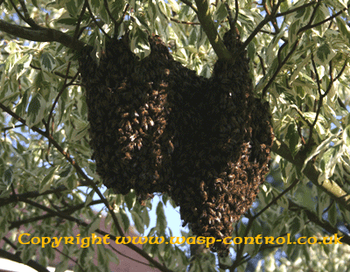
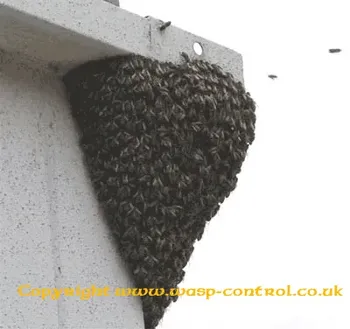
Honey Bee Swarm hanging from branch?
Have you noticed a honey bee swarm hanging from a tree branch? It's quite common for these swarms to temporarily land on trees, houses, roofs, or virtually anywhere. This behavior occurs when the swarm sends worker bees to find a suitable location for a new nest. Once the bees locate the ideal spot, the swarm relocates there. Typically, the original nest or hive is nearby when a swarm behaves like this. If you discover a bee swarm on your property, it's advisable to contact your local beekeeper, as the swarm likely originated from one of their hives.
Usually, a swarm remains in a location for no more than a day or two before moving on to its new permanent home.
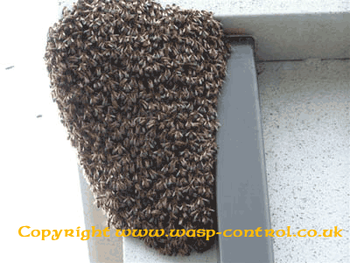
Require assistance with removing a bee swarm?
The good news is, when bees swarm in this manner, they are unlikely to sting or attack. In fact, during swarming, bees are in a positive mood as they have no nest or hive to defend. They have also gorged themselves on honey for the journey and find it hard to bend their abdomens in order to sting.
Another positive aspect is that bees can be relocated, and swarms can be safely removed. If you find yourself with a bee swarm on your property, our list of Bee Swarm Removers in the UK, USA and Canada may provide the help you need.
Most beekeepers are willing to come and take a swarm away. The process is usually quick and involves locating the queen within the swarm. If the swarm is hanging from a branch or bush, the method involves gently shaking the swarm into a basket and placing it on the ground. Any bees not initially in the swarm quickly gravitate towards the pheromone emitted by the queen. Within about half an hour, the process is complete, and the bees can be secured for transport, ensuring their safe removal.
While the majority of swarms with accessible queens can be taken away, challenges arise when bees have established themselves in hard-to-reach locations.
Bee removal
If you find yourself with a swarm establishing residence in a cavity wall or another challenging location where the queen cannot be retrieved, unfortunately, the only viable option is to eliminate the colony. The process is similar to dealing with a wasp nest, but when it comes to bees, there are additional considerations. For instance, if a bee colony has settled within a cavity wall, it's recommended to remove the honeycomb and it is a requirement to seal off any entrances to prevent contamination of other nearby bee colonies.
For detailed information on bee treatments, you can refer to additional resources. However, it's important to note that bee treatments may not be straightforward, as each situation is unique. It's advisable to consult with your local pest controller, who can provide guidance based on your specific circumstances. We prefer exploring all available options to relocate the bees whenever possible.
It's worth mentioning that many pest controllers no longer handle bee removal jobs due to increasing legislation. If you are unable to find a local pest controller willing to assist with bee removal, consider reaching out to your local bee association for further guidance.
Some success has been achieved in retrieving colonies from cavity walls using a one-way valve, allowing bees to exit but preventing re-entry. This method is still in the testing phase, and if proven effective, it's likely that more pest controllers will adopt this approach in the upcoming seasons.
For bees nesting in other locations, an extraction technique known as a "cut out" can be employed. For instance, if a colony has nested in a shed between the inner wall and outer wood cladding, the cladding can be removed to expose the honeycomb, and the entire colony can be extracted and relocated.
A few pest controllers are now turning to a relatively new tool called a "bee vac." As the name suggests, it's a modified vacuum cleaner designed to collect bees without causing harm. Bee vacuums are becoming more widely used in the removal of honey bee colonies, providing a faster method of collecting the bees.
Given the decline of bees for various reasons, it's crucial to make every effort to save them whenever possible.
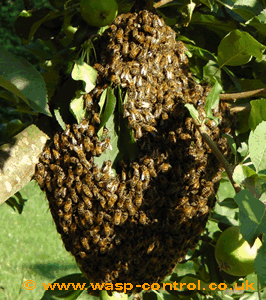
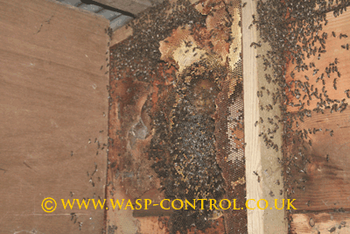
What does a honey bee nest look like?
In contrast to wasps, honey bees construct their nests using wax produced within the hive. The process begins with foraging bees collecting nectar from plants and flowers, which is then brought back to the nest or hive. Once there, house bees (young bees) take over and store the nectar in honeycomb cells for future use. If additional honeycomb is required, they utilize the nectar as a fuel source to generate wax from special glands on their bodies.
It's worth noting that approximately 8 pounds of nectar or honey is needed to produce just 1 pound of beeswax.
In the UK, most honey bee colonies are managed in hives by beekeepers. However, several decades ago, before the Varroa mite invasion, the UK supported a thriving population of wild bee colonies.
Honey bees housed in hives are provided with artificial frames on which they construct their honeycombs. These frames include a wax foundation sheet attached to facilitate the comb-building process. The hexagonal shape of each cell is embossed into the wax, expediting the construction of the honeycomb.
During the summer, when nectar is abundant and the colony is robust, a single frame can be fully developed into a functional comb overnight.
As depicted in the images, artificial honeycombs typically have a square or rectangular shape, while wild honeycombs tend to be more rounded in appearance. This difference in shape is influenced by the controlled environment of managed hives versus the natural settings where wild colonies establish their nests.
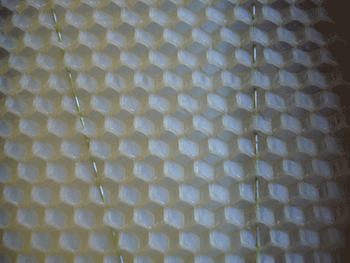
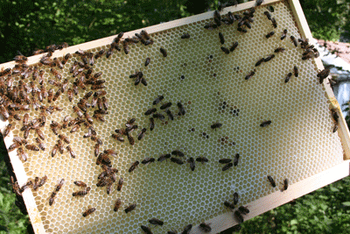
Please take a look at our List of Bee Swarm Collectors within the UK
If you are a bee swarm collector, please fill in the bee swarm collectors form, and we will add you to our list.


